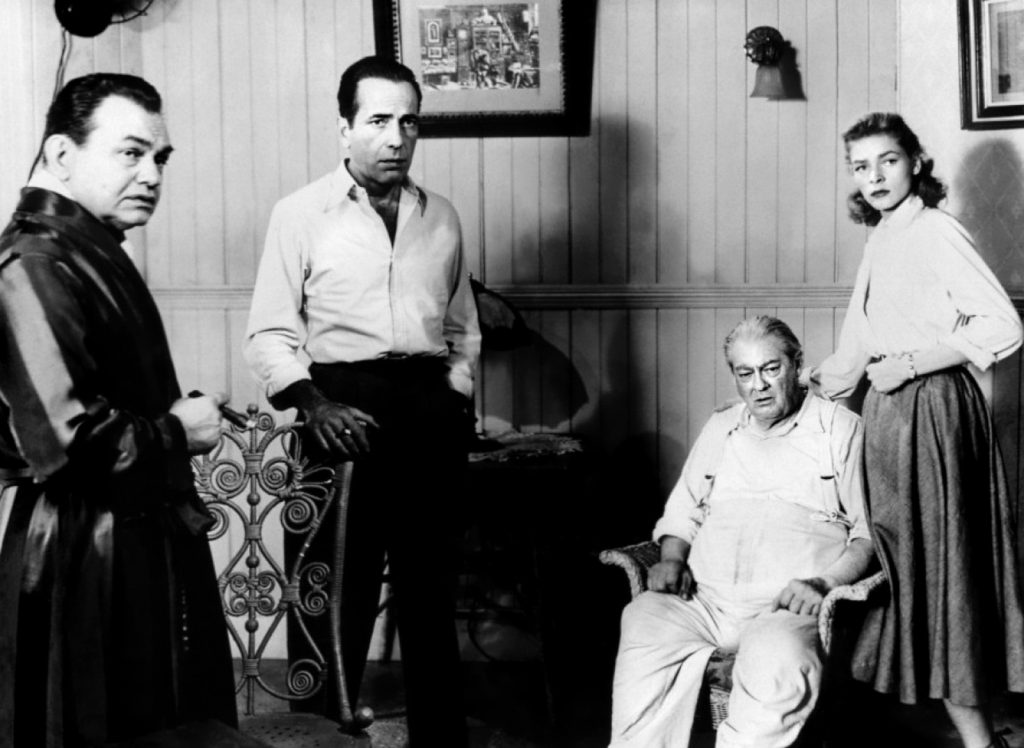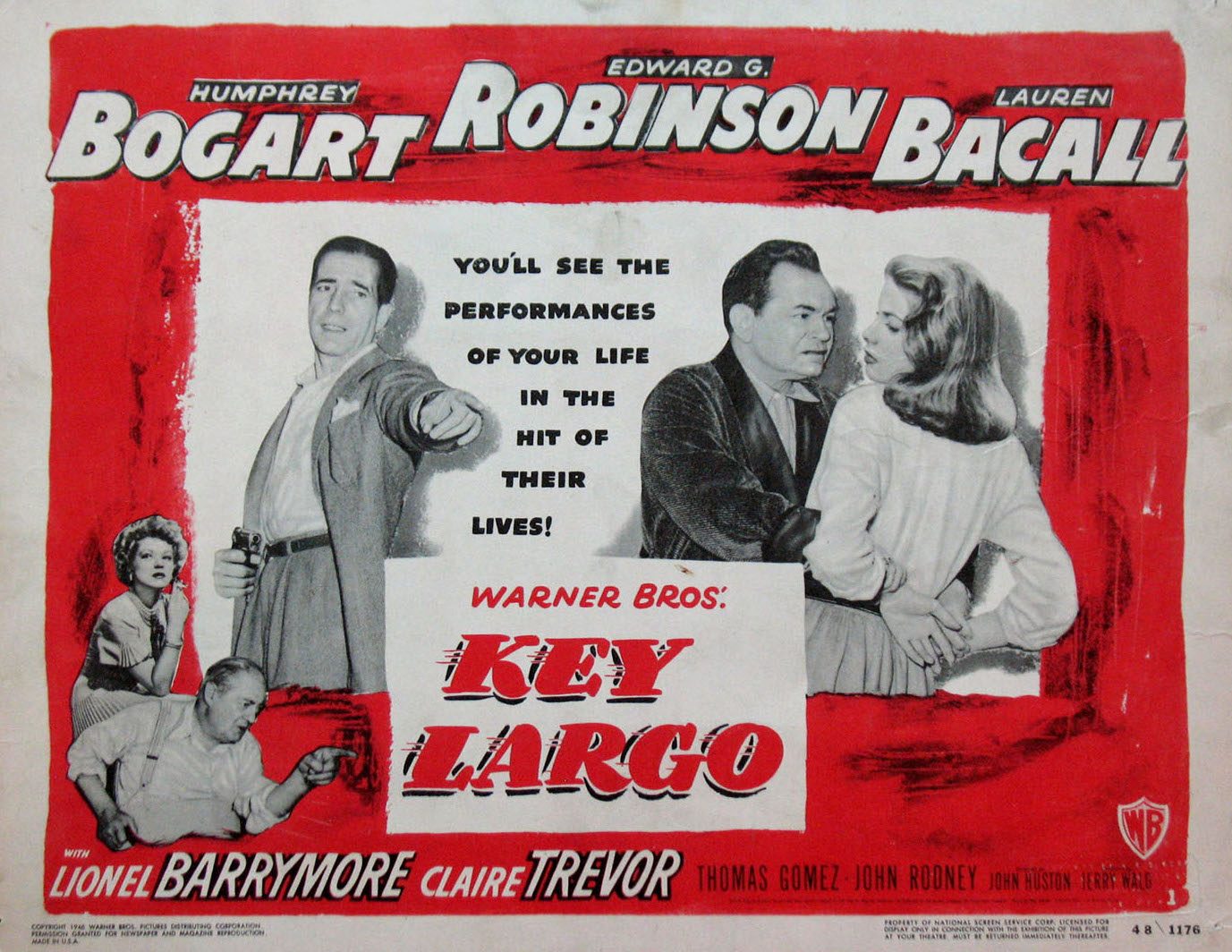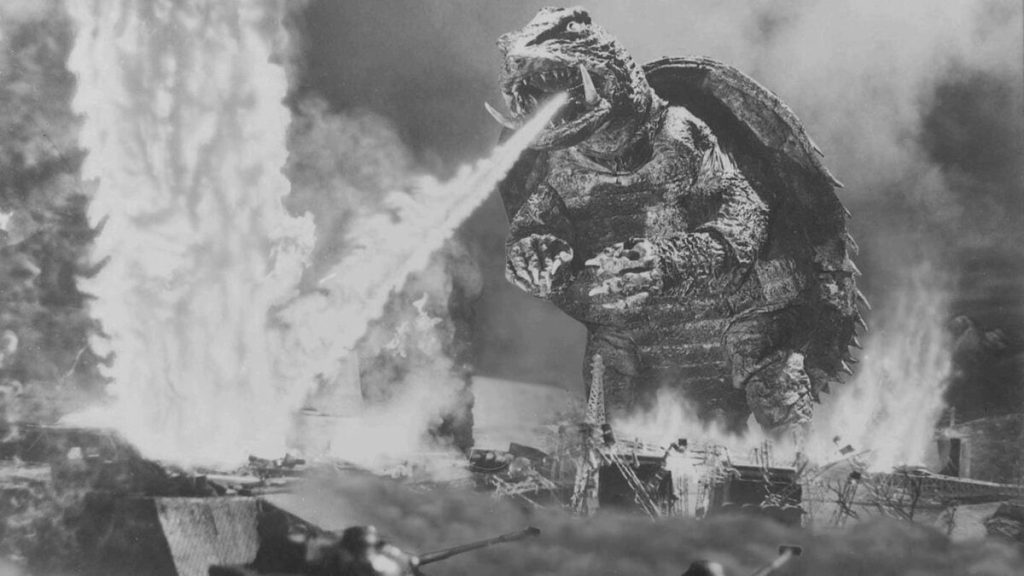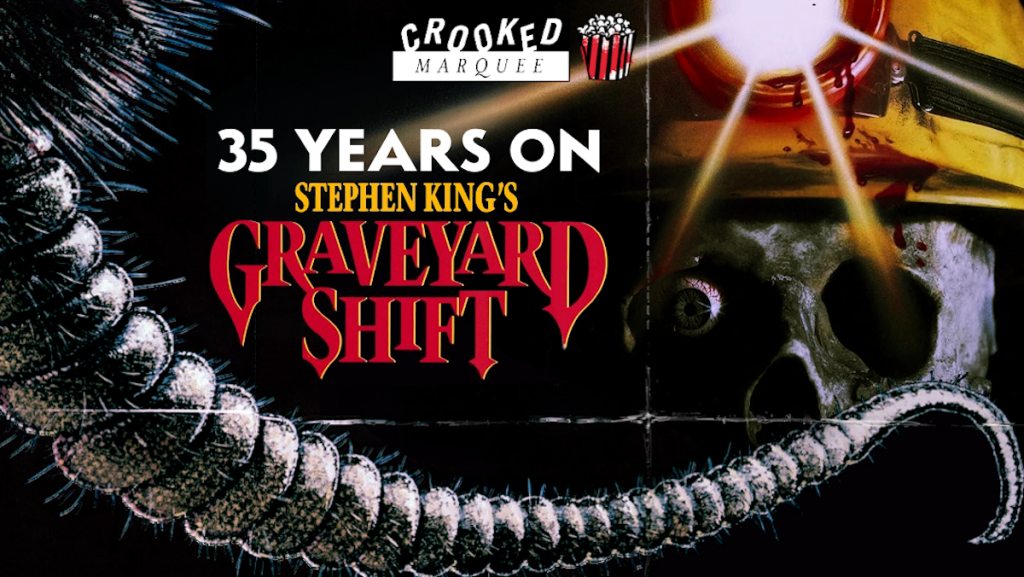John Huston’s 1948 masterpiece Key Largo is a timeless treasure. It is the best of postwar noir (i.e., Humphrey Bogart, mobsters, molls, and dark social critique) migrated to the tropics, dripping with humidity and decked out in palm trees, wicker furniture, fans spinning on the ceiling and dead fish mounted to the wall.
Loosely adapted from Maxwell Anderson’s 1939 Broadway play of the same name, Huston and Richard Brooks’ script is simply plotted: unmoored World War II war vet Frank McCloud (Bogart) arrives at the Hotel Largo—in order to visit his dead war buddy’s widow, Nora Temple (Lauren Bacall) and father, ‘Old Man’ Temple (Lionel Barrymore), the hotel’s proprietor—only to find it overtaken by gangsters, who McCloud will have to vanquish to save the day. The script is also wonderfully tense, thanks in large part to the hurricane, building up and bearing down on the hotel and those caught claustrophobically inside it: namely, the gangsters and their captives, respectively representing the sins and the better angels of the “American Way,” vying for the nation’s postwar soul. Belying its theatrical origins, Key Largo is talky, but its cinematic elements, along with the device of the mounting storm, keep the film clipping along, with its Max Steiner score and especially its cinematography, a master class in crisp black and white photography, elegant camera movement, deep focus, and deepening shadows.
Of course, credit for Key Largo’s timeless appeal also belongs to its stacked cast, some of classical Hollywood’s finest actors at the top of their games, making the most of its meaty dialogue. For my money, Key Largo is peak Bogart, his rugged handsomeness wrinkled just so. Playing McCloud, he reenacts the same conversion from world-wearied cynicism to heroic idealism that he enacted as Rick Blaine in Casablanca (1942) and Harry Morgan in To Have and Have Not (1944). Like these predecessors, Bogie’s conversion is inspired by the love of a good woman, this time (as in the case of the latter) played by Bacall, his young bride in real-life, in their fourth and final collaboration. Opposite Bogie and Bacall is veteran film gangster Edward G. Robinson, stealing all his scenes as mob boss Johnny Rocco, from the moment he first appears in a bathtub–a “crustacean without his shell,” Huston intended. Stage luminary Lionel Barrymore and character actress Claire Trevor round out the cast. The latter won the Best Supporting Actress Oscar for her gun-moll turned “lush” Gaye Dawn, Key Largo’s only nomination.
For all its vaunted timelessness, however, 21st century viewers of Key Largo can benefit from a map and key—to all the film’s specifically-named geographic places and their seven-decades old significations. After all, the film’s very title (and the trailer included below) underscore the film’s preoccupation with the specificity of place, which is ironic given that Huston was content to shoot it on a Warner Bros. sound stage in contrast to his previous film, Treasure of the Sierra Madre, for which he insisted upon on-location shooting.
Key Largo’s intertitle prologue locates the Florida Keys as the “southernmost point of the United States.” As contemporary viewers steeped in (racist) associations between the tropics and depravity would have understood, this was a measure of latitude and moral lassitude, a hint that Key Largo would explore America at its lowest. This association is cemented with the film’s treatment of Cuba, just 90 miles away, then the playground of American sins (with its casinos, brothels and drug smuggling) and the site where Rocco, has been hiding out for the past eight years, preparing his American comeback.

A Prohibition-era kingpin who got his start in the days of rum-running, Rocco is a composite of Lucky Luciano (then heading his criminal empire in exile in Havana) and Al Capone from Chicago (who Robinson fictionalized as Enrico Bandello in the pre-Code Little Caesar [1931]), despite the PCA’s edits to minimize the film’s gestures to both. As producer Jerry Wald argued against the censors’ trepidations, “certainly there is no better way to point [to] a moral than to use a gangster as a symbol of everything that we are trying to avoid going back to.” As an iron-fisted Italian-American, Rocco also expands Key Largo’s geography to the recently-defeated fascist Italy. As Huston explained, “[Bogart] comes up against a gangster who represents in miniature the same evils he fought against in the war.” So: Rocco is Rico is Capone/Luciano is Mussolini. And, as contemporary viewers likely intuited, Rocco is also HUAC, that Red-baiting Republican-led congressional committee then bearing down on Hollywood’s New Deal liberal-leftists like Huston, Bogart and Bacall. All three were front and center in Hollywood liberal’s high-profile Committee for the First Amendment, which defended HUAC’s “victims” and denounced its “fascistic tactics.”
Tropical and low-down as they may be, the Keys are given an alternative meaning in Key Largo. They represent a return to some prelapsarian America, where the dislocated McCloud (wandering the U.S. from specifically-named city to city) can find a place to call “home.” (See his first, rather stilted, line of dialogue: “Home being Key Largo.”) This meaning is encapsulated by the “Temples” and references to Matecumbe Key, the place where the film’s righteous Seminoles live in peace, however marginalized and unjustly persecuted elsewhere. But Matecumbe Key also carries less idyllic associations, namely with a deadly hurricane in 1935, about which Old Man Temple speechifies. As contemporary viewers knew, some 500 World War I “Bonus Army” veterans, working therein for the New Deal’s Civilian Conservation Corps, died when the evacuation train sent for them was late and then derailed. Ernest Hemingway wrote an article, “Who Murdered the Veterans?,” and congressional hearings followed, but nothing was done. Thus, Key Largo’s references to Matecumbe contribute to its message about America’s betrayal of ‘The Good’: of veterans and native peoples, of New Deal progressivism and wartime rhetoric.
This betrayal is made wrenchingly poignant by Key Largo’s references to “the Italian campaign” of World War II, to “Cassino” and “San Pietro,” where McCloud’s war buddy, George Temple gave his life. McCloud’s description of George’s final resting place matches the visuals of Huston’s own wartime documentary, The Battle of San Pietro (1945). Commissioned by the U.S. War Department to capture the Allies’ victorious march to Rome, Huston instead focused on bloody combat and the terrible toll on American life and limb with unprecedented realism, much to the War Department’s chagrin. As McCloud soliloquizes, American men like him fought and died because they “believed some words” of Franklin Roosevelt’s, which McCloud recites almost verbatim: “That we are not making all this sacrifice of human effort and human lives to return to the kind of a world we had after the last world war. That we’re fighting to cleanse the world of ancient evils, ancient ills.” (Given the reactionary political climate, Huston was surprised he got away with their inclusion.)
The return of Rocco confirms McCloud’s postwar disillusionment. As Huston explained in a letter to a friend, McCloud had “believed, along with the majority of humanity, that victory in the second World War would serve to uplift mankind…By the time the picture opens (the present) he, along with the rest of humanity, recognizes the total failure of these aims. He regrets the sacrifice of life of men of good will, as having been to no purpose, and he has resolved to live selfishly henceforward.”
Despite Huston’s cynicism, Key Largo has a happy ending, unlike so many other noirs—including the director’s own next noir entry, the equally masterful but even more disillusioned The Asphalt Jungle (1950). In Key Largo, Bogart can’t help but manifest the idealistic American hero he is at his core and risk his neck to take on the gangsters (“Your head says one thing but your whole life says another”). He wins the shoot-out on the boat bound for Cuba, and rights the ship, directionally and morally; we get a long shot of a compass turning to North. Radioing the authorities, Bogie gives his coordinates and asks to be patched through to the Temples. Nora takes the call and thanks God. Church bells ring on the soundtrack as she opens the shutters to let in a cleansing stream of post-storm sunlight.
That said, 21st century viewers will be excused for finding Key Largo’s cheery denouement inadequate to dispel the darkness it has explored in its other 95 minutes. For myself, I’m left thinking about Bogart/McCloud’s words at his most disillusioned: “If Rocco wants to come back to America, let him. Let him be President.” Now that’s dark.
“Key Largo” is now streaming on HBO Max.



